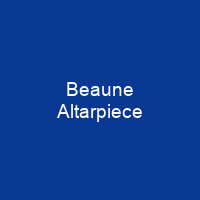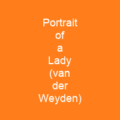The Beaune Altarpiece: A Masterpiece of Flemish Art
Imagine a masterpiece that has stood the test of time, telling stories of faith and judgment through its intricate panels. The Baune Altarpiece, painted by Rogier van der Weyden between 1443-1451, is such a work. Commissioned for the Hospices de Beaune in France, this large polyptych has been a beacon of spiritual guidance and warning for centuries.
The Commission and Construction
Commissioned by Nicolas Rolin and his wife Guigone de Salins, the altarpiece was intended as the centrepiece for their chapel. The story goes that around 1443, when the hospital was founded, Rolin approached van der Weyden to create this masterpiece. By 1451, the year the chapel was consecrated, the altarpiece was ready. Painted in van der Weyden’s Brussels workshop, it was a collaborative effort, most likely with the aid of apprentices.
The Altarpiece’s Structure and Function
Measuring 220 cm × 548 cm, the altarpiece comprises fifteen separate paintings across nine panels. When opened, it reveals an expansive ‘Last Judgement’ interior, resembling the upper portion of a cross when closed. The exterior panels serve as a funerary monument for the donors, with imagery set in the earthly realm.
Iconography and Symbolism
The polyptych provides comfort and warning to the dying, reminding them of their faith and directing their last thoughts towards the divine. St Sebastian and St Anthony represent healing, while St Michael as a guardian of the dead offers consolation in times of plague. The work conveys a dual function, distinguishing between figures of the divine, earthly, and hellish realms.
The Inner Panels
Inner panels feature grisaille-painted saints to imitate sculpture, with the T-shape configuration echoing typical configurations of Gothic churches. Figures extend across individual panels, ignoring panel separations. Christ and St Michael are enclosed within a single central panel for emphasis. The celestial sphere is dramatically presented with a radiant gold background, while the earthly realm contains gates to Heaven and Hell, emphasizing Christ’s reign.
The Upper Register
Christ sits in judgement, holding a lily and sword, on a rainbow extending across two panels. His right hand is raised in benediction, while his left is lowered to weigh souls against the scales held by Archangel Michael. The image echoes the representation in van der Weyden’s Braque Triptych.
The Archangel Michael
Archangel Michael embodies and conveys divine justice, positioned directly below Christ with a dispassionate expression and set of scales weighing souls. Unusually prominent for a ‘Last Judgement’ from the period, his prominence suggests he is about to move out of the canvas.
The Lower Panels
Lower panels depict souls across five lower panels, echoing the liturgy associated with the Mass for the Dead. Michael’s role in the Last Judgement is emphasized through color: his white alb contrasts with the cherubs’ red vestments. The saved walk towards the gates of Heaven, greeted by a saint, while the damned fall en masse into damnation.
The Heavenly and Hellish Realms
In Heaven, the Virgin Mary, John the Baptist, and apostles await Michael, accompanied by dignitaries and an assortment of unidentified individuals. Dead rise from their graves around Michael’s feet; some approach Heaven, others Hell. Heaven is represented as an entrance to a contemporary Gothic-style city illuminated by rays of light. The saved ascend a gilded church, while the damned enter Hell with bowed heads and drag each other in.
The Exterior Panels
The six exterior panels consist of two donor wings, two containing saints, and two panels with Gabriel presenting himself to Mary. St Sebastian was the saint of plagues and an intercessory against epidemics, Anthony the patron saint of skin diseases and ergotism.
Iconography on the Exterior
The use of grisaille is borrowed from van Eyck’s work, as is the treatment of the Annunciation. Van der Weyden uses iconography in the Beaune exterior that is not found in his other works, suggesting that Rolin may have asked that the altarpiece follow van Eyck’s example.
The Donors and Their Placement
Rolin and de Salins can be identified by the coats-of-arms held by the angels; husband and wife kneel at cloth-covered prie-dieux (portable altars) displaying their emblems. De Salins, traditionally thought of as an inferior position corresponding to Hell, is placed on the exterior right, linking her to Eve, original sin, and the Fall of man.
The Inscriptions
Beneath the lily is written: ‘Come ye blessed of my father, inherit the kingdom prepared for you from the foundations of the world’. Beneath the sword reads: ‘Depart from me ye cursed, into everlasting fire, prepared for the devil and his angels’. The inscriptions follow a 14th-century convention showing figures associated with the saved to Christ’s right and those of the damned to his left.
Condition and Restoration
A number of panels are in poor condition due to darkening of colours, dirt, and poor restorations. The altarpiece was hidden during the French Revolution and underwent restoration in 1875-1878. Despite these challenges, the moralising tone is evident from its iconography, choice of saints, and tilt of the scales.
Comparisons with Other Works
The work’s moralising tone can be compared to Matthias Grünewald’s Isenheim Altarpiece, which served much the same purpose. The similarities between the altarpiece and Hans Memling’s Last Judgement by van der Weyden’s apprentice have led art historians to suggest a common tie with Florentine banker Angelo Tani who gave commissions to van der Weyden before his death in 1464.

The Baune Altarpiece stands as a testament to the enduring power of art in conveying complex spiritual messages. Through its intricate details and powerful symbolism, it continues to inspire and educate those who seek guidance in their faith.
You want to know more about Beaune Altarpiece?
This page is based on the article Beaune Altarpiece published in Wikipedia (retrieved on November 29, 2024) and was automatically summarized using artificial intelligence.







